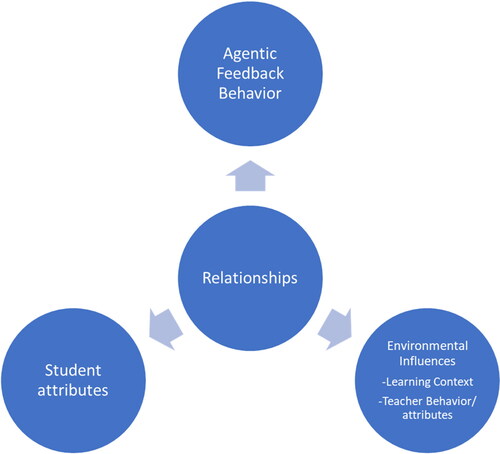#22 Feedback: Who owns it?
Episode Host: Linda Snell.

Enjoy listening to us at your preferred podcast player.
Episode article:
McGinness, H. T., Caldwell, P. H. Y., Gunasekera, H., & Scott, K. M. (2023). “Every Human Interaction Requires a Bit of Give and Take”: Medical Students’ Approaches to Pursuing Feedback in the Clinical Setting”. Teaching and Learning in Medicine, 35(4), 411–421.
Students say they don’t get enough, or enough ‘good’ feedback … teachers say they deliver lots and do it well. Could some of this tension be because the role of the learner in the feedback process is underemphasized? Students must have ‘feedback literacy’ and use behaviors that facilitate effective feedback … but what does this actually involve? Is it an issue with ‘triadic reciprocal interplay’?
Background
We don’t always pick papers for the results – sometimes it’s because of a new theory, or the opportunity to discuss a methodology.
Feedback as a two-way interaction between teacher and learner, with students’ having a central role in the process. This relationship is like a clinical therapeutic alliance: feedback effectiveness and achievement of goals depends on the quality of the relationship. Studies have looked at the interplay of and influences on teacher, learner and context during feedback.
Aspects of agentic* student feedback behavior are recognizing, seeking, evaluating, and utilizing feedback. Understanding the interactions between things that influence learner feedback behavior may help optimize student feedback behavior.
The authors’ underlying theoretical framework is Bandura’s Social Cognitive Theory (SCT) of a causational model of behavior. In this, the Triadic Reciprocal Causation (TRC) concept describes reciprocal (not unidirectional) interplay between personal factors, environmental influences, and behavior. These factors ”operate as interacting determinants that influence each other bidirectionally.”
*Agentic: an individual’s power to control his or her own goals, actions and destiny
Feedback to early-stage clinical learners is particularly important. These students may not have received feedback of this type before.
Research questions:
To explore influences on medical student feedback behavior during clinical attachments:
1) How do student attributes and the clinical learning context influence student feedback behavior and what are the interactions between these? 2) How does the student-teacher relationship (and roles within this) interplay with student feedback behavior?
Method
A ‘qualitative approach involving focus group discussions, analyzed through theoretical thematic analysis, based on Social Cognitive Theory.
Context – 6-week pediatrics block in an Australian medical school, with multiple opportunities for formal and informal feedback.
7 focus groups with 46 medical students described well.
Initial analytic framework – existing characterizations of student feedback behavior and the educational alliance model with focus on teacher/learner relationship and roles. During initial data analysis, results looked like the TRC model, so this was adopted for further analysis and interpretation, leading to conceptualizing emerging interactions between influences on feedback behavior. Coding assisted by N-vivo
Results/Findings
Determinants of student feedback behavior were environmental influences, student attributes, and relationships between teachers and students. Key themes were the interactions therein: between student feedback behavior and environmental influences (the clinical learning context): between student feedback behavior and environmental influences (teacher attributes and behaviors); between student attributes and student feedback behavior; between student attributes and environmental influences of teacher attributes and behaviors, and between relationships and the determinants of student feedback behavior. Best shown in the diagram.

The discussion shows nice links with the prior literature, in most cases supporting what is already known. Their model further develops the concept of interconnectedness, characterizing the backward and forward effect of one factor on another. The authors propose that interventions that target multiple aspects of the triadic model, the potential for impact is multiplied.
Comment
The authors conclude “in student feedback behavior… educational relationships are a central and mediating influence on the other key factors of student attributes and environmental factors (involving the clinical learning context and teacher characteristics).“
Resources and references
KIPRIME podcast episode 12 – Liz Molloy
How feedback literacy is enacted in the health workplace – an interview with Dr Liz Molloy.

Dr Liz Molloy is Professor in Work Integrated Learning in the Department of Medical Education at Melbourne Medical School and Academic Director of Interprofessional Education and Practice in the Faculty of Medicine, Dentistry and Health Sciences.
Molloy, E., Boud, D., & Henderson, M. (2020). “Developing a learning-centred framework for feedback literacy. Assessment & Evaluation in Higher Education“, 45(4), 527–540.
Molloy, E., Ajjawi, R., Bearman, M., Noble, C., Rudland, J., & Ryan, A. (2020). “Challenging feedback myths: Values, learner involvement and promoting effects beyond the immediate task. Medical Education“, 54(1), 33–39.
Lingard, L. (2017). “Does your discussion realize its potential? Perspectives on Medical Education“, 6(5), 344–346.

0 comments